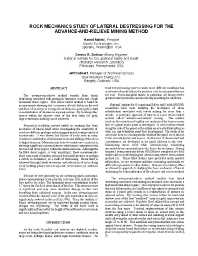Mining Publication: Rock Mechanics Study of Lateral Destressing for the Advance-and-Relieve Mining Method
Original creation date: August 2003
The advance-and-relieve method benefits from lateral destressing associated with mining in laminated rocks and a high horizontal stress regime. This stress control method is based on measurements showing that occurrence of rock failure in the roof and floor of an entry (or caving of roof strata in a panel gob) results in redistribution of stresses in adjacent entries. By locating other entries within the shadow zone of the first entry (or gob), improvements in stability can be achieved. Numerical modeling proved useful in studying the basic mechanics of lateral relief while investigating the sensitivity of results to different geologic and mining parameters using controlled experiments. It was shown that failure of rocks near an entry results in redistribution of horizontal stress and shifting of the stress to higher horizons. Measurements from two mines are consistent in showing significant horizontal stress reductions in comparison with the far-field stress regime within the destressed zone. Although the far-field stress regime is very anisotropic, these measurements show near-equal secondary principal horizontal stresses, or perhaps a switch in orientation, as a result of destressing. Stress relief is achieved through lateral movement and relaxation of rocks along weak bedding planes toward adjacent caved zones (or softened zone). Because of cave geometry in the advancing panel, horizontal stress concentrations occur near the cave line both in front of the face and to the sides. The horizontal stress concentration reaches 1.7 times the far-field stress ahead of the face. This stress increase is significant and may cause structural damage in this zone benefitting from additional support. In the next advancing panel located within the shadow zone of the gob, horizontal stresses are significantly reduced in the roof (by 50%). Thus, the stability of future advancing panel can be improved through prudent layout designs and sequencing. The width of the relief zone is significantly influenced by the height of the softened (or cave zone) and rock mass properties.
Authors: H Maleki, DR Dolinar, J Dubbert
Conference Paper - August 2003
NIOSHTIC2 Number: 20023432
In: Peng SS, Mark C, Khair AW, Heasley KA, eds. Proceedings of the 22nd International Conference on Ground Control in Mining. Morgantown, WV: West Virginia University, 2003; :105-113
See Also
- Advance and Relieve Mining: A Method to Mitigate the Effects of High Horizontal Stress on the Mine Roof
- AHSM - Analysis of Horizontal Stress Effects in Mining - 2.4.04
- Elastic and Shear Moduli of Coal Measure Rocks Derived from Basic Well Logs Using Fractal Statistics and Radial Basis Functions
- Evaluation of the Bagged Stone Dust Barrier Effectiveness in a Bord and Pillar Mine
- Horizontal Stress
- Horizontal Stress and Longwall Headgate Ground Control
- Numerical Modeling of Paste Sills in Underhand Cut & Fill Stopes
- Reservoir Rock Properties of Coal Measure Strata of the Lower Monongahela Group, Greene County (Southwestern Pennsylvania), from Methane Control and Production Perspectives
- Safer Mine Layouts for Underground Stone Mines Subjected to Excessive Levels of Horizontal Stress
- Utilizing the 'Advance and Relieve' Method to Reduce Horizontal Stress Affects on the Mine Roof, A Case Study
- Variation of Horizontal Stresses and Strains in Mines in Bedded Deposits in the Eastern and Midwestern United States
- Page last reviewed: 9/21/2012
- Page last updated: 9/21/2012
- Content source: National Institute for Occupational Safety and Health, Mining Program


 ShareCompartir
ShareCompartir
